

Pharmaceutical companies splash millions on Australian nurses. Pharmaceutical companies have spent millions of dollars wining and dining Australian nurses in recent years, as well as paying for them to attend overseas conferences, training courses and even coffee meetings.
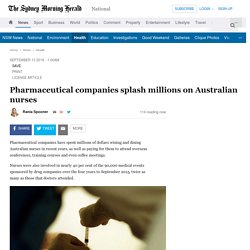
Nurses were also involved in nearly 40 per cent of the 90,000 medical events sponsored by drug companies over the four years to September 2015, twice as many as those that doctors attended. The cash splash was revealed after academic analysis of member data reported by industry group Medicines Australia and has raised concerns that it could influence decision-making. It showed of $12.5 million spent on functions for nurses about $3 million was for "food and beverages". The remainder was spent on things such as conference sponsorship, flights and accommodation.
"The concern is that the promotional activities of these industries are going to influence decision-making about patient care or treatment in ways that might not be evidence based, safe or effective. " Labor unveils nurse training package as campaign arm-wrestle on health continues. Labor has pledged to help establish an advanced nursing masters course, use it to train 10 public health nurses a year, and offer post-graduate scholarships to 39 others.
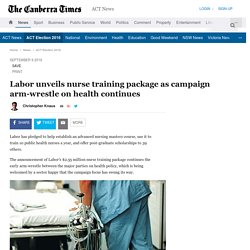
The announcement of Labor's $2.55 million nurse training package continues the early arm-wrestle between the major parties on health policy, which is being welcomed by a sector happy that the campaign focus has swung its way. Last month, the Liberals announced a major $395 million upgrade to Canberra Hospital, and two small satellite hospitals in Tuggeranong and Gungahlin. Labor countered this week with its $650 million health package, which would see a new building at the Canberra Hospital, a new emergency department, and an expansion of the recently completed women and children's hospital. Chief Minister Andrew Barr has now announced Labor would work with the University of Canberra to establish a course for nurse practitioners, a masters degree qualification which is currently unavailable in the ACT.
Workforce. Health workforce. Aboriginal and Torres Strait Islander people - information about health workforce Programmes specifically assisting Aboriginal and Torres Strait Islander people.

Allied Health Professionals - Information on training opportunities and support initiatives for allied health professionals. Dentists - Information on training opportunities and support initiatives for dentists. Maternal deaths in Australia 2008â2012. Maternal deaths in Australia 2008–2012 is the 16th report on women who die in association with pregnancy and childbirth.
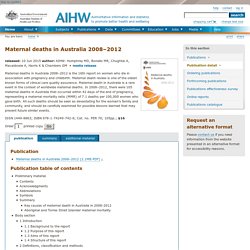
Maternal death review is one of the oldest known forms of clinical care quality assurance. Maternal death in Australia is a rare event in the context of worldwide maternal deaths. In 2008–2012, there were 105 maternal deaths in Australia that occurred within 42 days of the end of pregnancy, representing a maternal mortality ratio (MMR) of 7.1 deaths per 100,000 women who gave birth.
Sue Desmond-Hellmann: A smarter, more precise way to think about public health. How can Australia do better for Indigenous health? Respect, tolerance and trust in Aboriginal and Torres Strait Islander people are needed from government to improve the health and wellbeing of Indigenous Australians Reflecting back over 30 years of working in Indigenous health, I think that it has been a time of change rather than improvement.
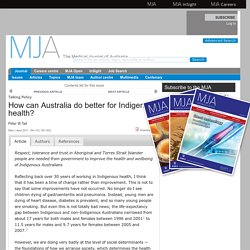
This is not to say that some improvements have not occurred. No longer do I see children dying of gastroenteritis and pneumonia. Instead, young men are dying of heart disease, diabetes is prevalent, and so many young people are smoking. Improving the health of Indigenous Australians: reforms in nursing education. An opinion piece of international interest - Turale - 2006 - International Nursing Review. Summary of developments in Indigenous health promotion « Reviews « Health promotion « Health infrastructure. Last update: 2005 Peer review: No Introduction Health promotion has been described as: 'the process of enabling people to increase control over, and to improve their health.

To reach a state of complete physical, mental and social wellbeing an individual or group must be able to identify and realise aspirations, to satisfy needs and to change or cope with the environment.' or, more simply, as. Measuring progress against the Sustainable Development Goals and implications for Australia - IOD PARC Australasia. In September 2015 UN member states committed to the 2030 Agenda for Sustainable Development – with 17 Sustainable Development Goals (SDGs) and 169 targets.

The 17 SDGs aim to build on what was achieved under the Millennium Development Goals (MDGs) 2000-2015. They aim to eradicate extreme poverty and ensure sustainable (economic, social and environmental) development. This agenda is incredibly ambitious. Where the MDGs focused on improving the livelihoods of the poorest and most vulnerable in developing countries, the SDGs apply to all member states. Developing countries will continue efforts to improve outcomes in areas such as extreme poverty, health and education. The estimated financial cost required to achieve all SDG targets by participating countries varies considerably. Reaching agreement on global development targets is a remarkable achievement in itself. The Australian public reasonably expects the assistance it provides to developing countries to be used effectively. SDGsAustraliaMay14 WorkshopReport Final. National Drug Strategy - National Drug Strategy.
Home The National Drug Strategy (NDS) and its forerunner, the National Campaign Against Drug Abuse (NCADA), have been operating since 1985.
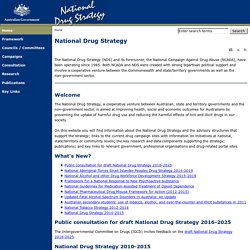
About - TAC - Transport Accident Commission. Media room The TAC's media team provide media and the public with information about the TAC and road safety issues.
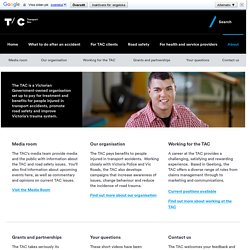
You'll also find information about upcoming events here, as well as commentary and opinions on current TAC issues. Visit the Media Room Our organisation The TAC pays benefits to people injured in transport accidents. Find out more about our organisation. Indigenous health. 7.0 Introduction While there have been improvements in the health and wellbeing of Aboriginal and Torres Strait Islander Australians in recent years, some long-standing challenges remain.
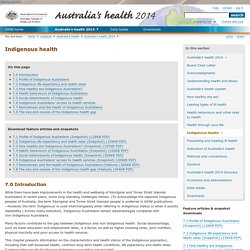
(To acknowledge the separate Indigenous peoples of Australia, the term 'Aboriginal and Torres Strait Islander people' is preferred in AIHW publications—however, the term 'Indigenous' is used interchangeably when referring to Indigenous status or when it assists readability.) Across many indicators, Indigenous Australians remain disadvantaged compared with non-Indigenous Australians. Australian Road Deaths Database. The Australian Road Deaths Database provides basic details of road transport crash fatalities in Australia as reported by the police each month to the State and Territory road safety authorities. Details provided in the database fall into two groups: the circumstances of the crash, for example, date, location, crash typesome details regarding the persons killed, for example, age, gender and road user group. When is the data updated? The fatality data is updated every month.The heavy vehicle flags (for articulated truck, heavy rigid truck and bus involvement) are only updated each quarter, and are current to within two months.
Information for heavy rigid truck involvement in crashes earlier than 2004 is incomplete. Alcohol use (NDSHS 2013 key findings) The consumption of alcohol is widespread within Australia and entwined with many social and cultural activities. Current use and trends Daily drinking declined significantly between 2010 and 2013 (from 7.2% to 6.5%) and was at the lowest level seen since 1991. Rates fell for both males and females.Between 2010 and 2013, there was a significant increase in the proportion of people who had never consumed a full serve of alcohol (from 12.1% to 13.8%). Fewer people aged 12–17 are drinking alcohol and the proportion abstaining from alcohol increased significantly between 2010 and 2013 (from 64% to 72%).Younger people are continuing to delay starting drinking—the age at which 14–24-year-olds first tried alcohol has increased since 1998 from 14.4 to 15.7 years in 2013.
Risky drinking Lifetime risky drinkers are defined as people who consume more than 2 standard drinks per day (on average over a 12 month period). Statistics - Drug Prevention & Alcohol Facts. Below is a brief outline of some important Australian statistics on drugs. Find more statistics: Statistics by drug: Statistics by topic: Overdose Alcohol National Alcohol is the most widely used drug in Australia. Mindhealthconnect. There are many treatment options available for addictions and substance abuse, ranging from counselling through to hospital treatment depending on which substance is used and how serious the dependence is. Mild substance abuse can be treated by simple counselling and lifestyle changes. Severe dependency on substances like alcohol and heroin can require treatment in a hospital. Detoxification means stopping the substance and having medical treatment until the substance has cleared from the bloodstream.
Rehabilitation (going to ‘rehab’) refers to longer-term treatment, which can happen in a residential clinic or at home. This often involves psychological treatments to address any underlying issues that have caused the initial substance misuse, such as childhood trauma, anxiety or depression. From Policy to Action. Home — Roll Back Malaria. Sexual & reproductive health. HIV & AIDS. An evolving challenge HIV first shocked the world when it emerged in developed countries in the 1980s, largely among men who have sex with men.
It soon exploded in poor countries, killing tens of millions of people. Sub-Saharan Africa was hit hardest; it still accounts for over 70 per cent of new infections. Over the last decade and a half, an unprecedented global response has made HIV prevention and treatment services available in almost every country in the world. Development, implementation and evaluation of a clinical research engagement and leadership capacity building program in a large Australian health care service. The benefits to patient care and service delivery can be greatly enhanced with research that is led by the health professionals who will use it, making it relevant to the health care setting. The benefits of health research designed to deliver relevant healthcare improvements have the potential to span the patient experience, improvements in healthcare outcomes and to facilitate efficient use of resources [1].
Australian Health Survey. SDSN Australia/Pacific. Overview Following the Rio+20 United Nations (UN) Conference on Sustainable Development, world governments embarked on a process to develop universal Sustainable Development Goals (SDGs). SDG 3: Good Health and Wellbeing. SDG Goal #3 United Nations Sustainable Development Goals. We can't close the gap on health unless we talk about nutrition. Fight against AIDS threatened by lack of money, leadership, UN head says. New York: Global progress fighting AIDS could be lost because prevention programs are suffering from a lack of leadership, accountability and funding, the head of the United Nations has warned. Strengthening maternal immunisation to improve the health of mothers and infants. Analysis of selected social determinants of health and their relationships with maternal health service coverage and child mortality in Vietnam.
Sdgsforaustralia interimreport. Reducing disease risks and improving food safety in smallholder pig value chains in Vietnam. CDC Global Health - Vietnam - Why We're Here. Skip directly to search Skip directly to A to Z list Skip directly to navigation Skip directly to page options Skip directly to site content. Global Health Action. Viet Nam: country profiles. CME Info - Child Mortality Estimates. Geoba.se: Gazetteer - Vietnam - 2016 - Statistics and Rankings. Healthcare in Vietnam. Goal 3.